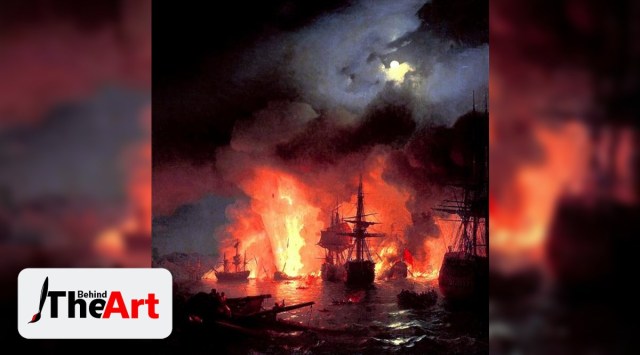- India
- International
Behind the Art: The Battle of Cesme illuminated: Ivan Aivazovsky’s masterpiece and its historical significance
Behind the Art: Ivan Aivazovsky, the renowned Armenian-Russian artist, captured a historic battle in his masterpiece, "Battle of Cesme at Night." The painting's exceptional artistry and its portrayal of a pivotal moment in history grant it the status of a respected masterpiece and a significant historical document.
 Battle of Cesme at Night, Ivan Aivazovsky, 1848 (Source: wikiart.org)
Battle of Cesme at Night, Ivan Aivazovsky, 1848 (Source: wikiart.org) In 1770, during the Russo-Turkish War, a naval battle took place at Cesme Bay, a strategic location in the Aegean Sea. The battle was fought between the Ottoman Empire and the Russian Empire, with Admiral Alexei Orlov leading the Russian fleet. It was a dark, moonless night and both sides were preparing for the impending confrontation. As the battle began, the sea was illuminated by the flash of gunfire and explosions. The Turkish ships fired cannons, and the Russians responded with their artillery. The sound of the battle echoed across the water, creating a deafening roar that could be heard for miles. Despite their best efforts, the Ottoman fleet was unable to resist the Russian onslaught, and the battle ended in a decisive victory for the Russian Empire. Years later, in 1848, the renowned Armenian-Russian artist Ivan Aivazovsky depicted the Battle of Cesme in a painting titled “Battle of Cesme at Night.” Why is the painting considered to be a masterpiece and regarded as an important historical document?
The painting and the naval battle
The Chesme battle of 1770 was a heroic moment for the Russian side during the Russo-Turkish War of 1768-1774. In the early hours of June 26th, 26 Russian warships attacked the larger Turkish fleet of 63 ships, locking them in Chesme Bay and inflicting heavy damage. Count Orlov reported that the Turkish fleet was “broken, burned, the sky empty, the ashes drew” and the Russians emerged victorious. In 1844, Ivan Aivazovsky became the official painter of the Navy after returning from Europe. He began to take an interest in historical battle painting, leading him to create the famous “Chesme Battle” painting. The painting depicts the night battle with the burning Turkish ships visible in the background. The explosion of one of the ships sends fragments flying through the air, resembling fireworks. A Russian boat is also seen approaching the flagship after Lieutenant Ilyin blew up an enemy ship using explosives.
Just by looking at the painting, one can see that the painting’s colour palette is striking, featuring warm, blazing colours to depict the battle at sea and cold, gloomy tones for the moonlit sky. According to historians, Aivazovsky did not pay heed to what the artists of his time said, rather he paid great attention to detail, consulting with admirals and sailors to ensure accuracy in his paintings. His work was highly regarded by the Navy, and in 1846, a squadron led by Admiral Kornilov even came to celebrate the tenth anniversary of his activities in Feodosia. A lesser-known fact about the painting “Battle of Chesme at Night” is that Ivan Aivazovsky drew from his own experience at sea when creating it. Aivazovsky was an avid sailor who spent a significant portion of his life at sea, which gave him a profound knowledge of water’s nature and behaviour. His personal experience allowed him to add a level of realism and authenticity to the painting that might not have been possible otherwise.
The historical importance of the painting
The painting “Battle of Cesme at Night” by Ivan Aivazovsky is historically important for multiple reasons. Firstly, it depicts a significant naval battle that took place during the Russo-Turkish War of 1768-1774, showcasing the victory of Admiral Alexei Orlov’s Russian fleet over the Ottoman Empire. The painting, like other paintings of naval battles, preserves this crucial event in history and serves as a visual representation of the battle. Secondly, the painting is considered to be a masterpiece of the Romantic era, showcasing Aivazovsky’s artistic talent in capturing the dramatic effects of light on water. The painting has received critical acclaim for its vivid and lifelike portrayal of the violent and chaotic naval battle. The painting also holds cultural significance as a symbol of the Russo-Turkish War and naval history. It is widely considered one of Aivazovsky’s most distinguished works and holds great value in both the art world and among those interested in naval history.
The historical accuracy of the painting
Aivazovsky was not the only artist who painted a naval battle based on reports and historical documents. Paintings such as Édouard Manet’s The Battle of the Kearsage and the Alabama, 1864, are prime examples of artwork made based on sources and information showcased to the public. Thus, it is important to note that The “Battle of Chesme at Night” by Ivan Aivazovsky is a historical painting and not a photograph or documentary piece. While Aivazovsky is known for his meticulous attention to detail and consultation with naval experts, it is essential to mention that artistic license may have been taken in his interpretation of the battle. Moreover, the painting was created in 1848, almost 80 years after the battle took place in 1770, which means that there may be some inaccuracies due to the passage of time and the availability of historical records.

Despite these potential limitations, the painting is widely regarded as a highly accurate and vivid portrayal of the battle and remains to be a masterpiece to date.
Next up in Behind the Art: The Role of Art in Celebrating Military Victories: Velazquez’s The Surrender of Breda
📣 For more lifestyle news, follow us on Instagram | Twitter | Facebook and don’t miss out on the latest updates!
May 07: Latest News
- 01
- 02
- 03
- 04
- 05



































